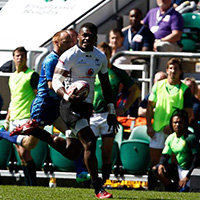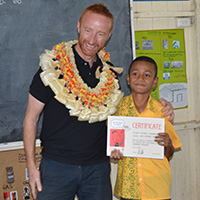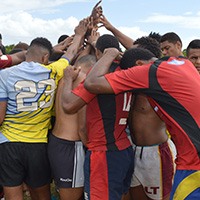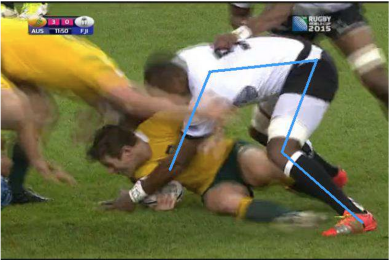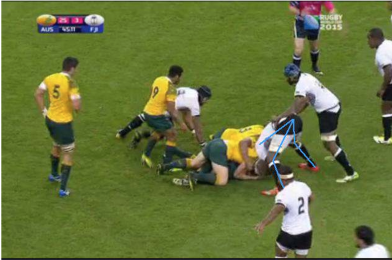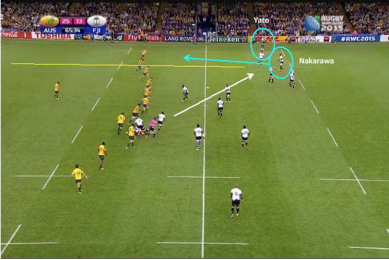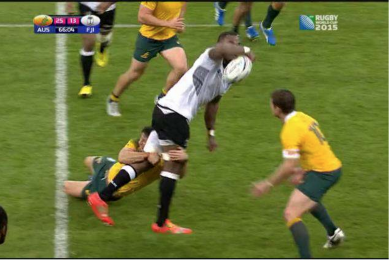Farewell to a Fijian phenomenon – the World Cup will miss Leone Nakarawa
LONDON, 8 Oct – Rugby World Cup 2015 has lost one of its most outstanding players.
Leone Nakarawa and Fiji ended their RWC 2015 campaign with a 47-15 win over Uruguay, and with 32 pool matches completed across the tournament, the lists that measure individual performance in the tournament are almost all marked with a bit of the Glasgow Warriors’ second-row.
As of October 8, Nakarawa leads the tournament for offloads (10) and turnovers won (9), meaning the lock forward steals ball like David Pocock and offloads like Sonny Bill Williams. Or rather, they do it like he does, as he is ahead of both of them on the list of their respective specialities.
He is also fifth for most runs made (42), seventh for carries over the gainline (19), and in the top 20 of another two categories: 16th for most metres made (177m) and 20th for most tackles made (34). His presence in so many of the lists indicates a player who is, at the very least, central to the action in defence, and a huge threat in attack.
And huge is the right word. Nakarawa stands 1.98cm and weighs 117kg (6ft 6in, 18st 6lb), but his body frame is very much in proportion, which keeps him agile and quick. His agility allows him to stoop and steal ruck ball, and adjust his body shape for offloads; his speed allows him to utilise space and break the gainline when opportunities present themselves.
MAN OF THE MATCH
Not surprisingly, he has represented Fiji in sevens, both in the World Series and the 2013 Rugby World Cup Sevens in Russia.
An offload for a try assist and a try of his own from a wide support run (pictured) were conspicuous enough to earn Nakarawa the man-of-the-match award against Uruguay, but statistically – apart from lineout takes – it was one of his lesser RWC 2015 performances. He and captain Akapusi Qera were the only Fiji players who played all 80 minutes in every match, and his contributions against the stronger Pool A teams were more telling.
He did not go looking for tackles, but tackled securely when he needed to. Fiji’s defensive pattern did not rely on forwards racing to take guard positions or contest pick-and-drives. Instead of reshaping, players stayed where they were rather than trying to rearrange the defensive line by position. As a result, Nakarawa often found himself in defensive positions normally occupied by a centre, and this meant he was often the first or only forward to arrive at a ruck if play spread quickly. He forced a penalty turnover this way against England’s outside centre Jonathan Joseph in the first 10 minutes of the opening match of the tournament.
Nakarawa, 27, also showed sound judgement, stalking rucks and carefully picking high-percentage turnover chances, rather than blindly throwing his weight into slowing down ruck ball. Against Australia he twice profited when he attempted to strip the ball from Bernard Foley after he had been tackled, and forced the fly-half to hold on to it illegally and concede penalties. He used two different, but equally effective, types of body positioning:
First – a wide foot base that allowed him to get low and stable, and reach forward
Second – more upright, but with a perfect hinge from the hips
Nakarawa was the focal point of Fiji’s counterattacking game that looked to make use of his outstanding offloading skills, developed in his Sevens background. He is Fiji’s leading try scorer of 2015 with five, and helped inspire them to the 2015 World Rugby Pacific Nations Cup title with a double in the final against Samoa. In the 2014-15 European Rugby Champions Cup he made 25 offloads, nine more than any other player, despite Glasgow – where he is known as ‘Big Naksy’ – playing only in the pool phase.
He is quick enough over short distances that defenders have to pay him respect and stop him as quickly as possible, but his size means he draws multiple defenders and Fiji made good use of that. He is usually stationed in one of the 15m channels on the opposite side of the field to stretch the opposing defence, and in tandem with at least one back-rower (Peceli Yato in the example below), his job was to wait for possession to arrive, then draw contact and release his support player.
His height helped his offloading, and he deliberately got his arms high in contact to keep his passing options open and the ball alive. Against Australia he was able to draw double tackles on various occasions. The first man invariably went low to get him to ground, but before the second man arrived high, his excellent awareness of the players around him meant he was able to get his body shape right for a fend and/or offload.
He was also capable of fulfilling the other side of the role, and his try against Uruguay showed some classic attacking skills. He ran a simple inside support line off Nemani Nadolo’s break, then ran into the space with ball out in front of him in two hands to keep the defender ahead of him guessing. With the defender unable to make a decision, it was easy to throw in a fake and wrong-foot him for a simple run in.
Nakarawa’s all-round game, honed in the space and speed of Sevens, and developed with the Glasgow Warriors in Pro 12 and Champions Cup rugby, has been a revelation to the wider audience of RWC 2015. Despite Fiji’s exit at the Pool stage, their second-row’s athleticism, skill, and intelligence will live long in both the memory and the statistical records.
RNS ct/as/bo
(Source: http://www.rugbyworldcup.com/news/108039)


